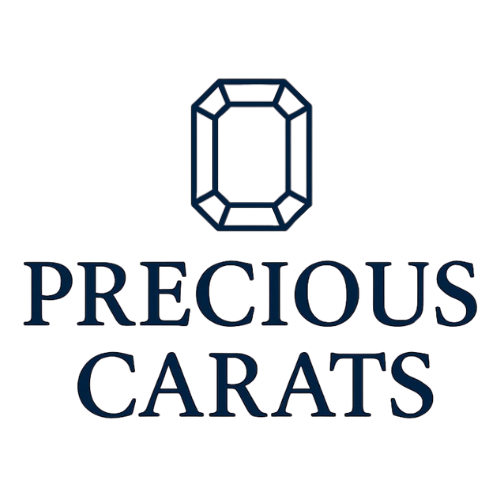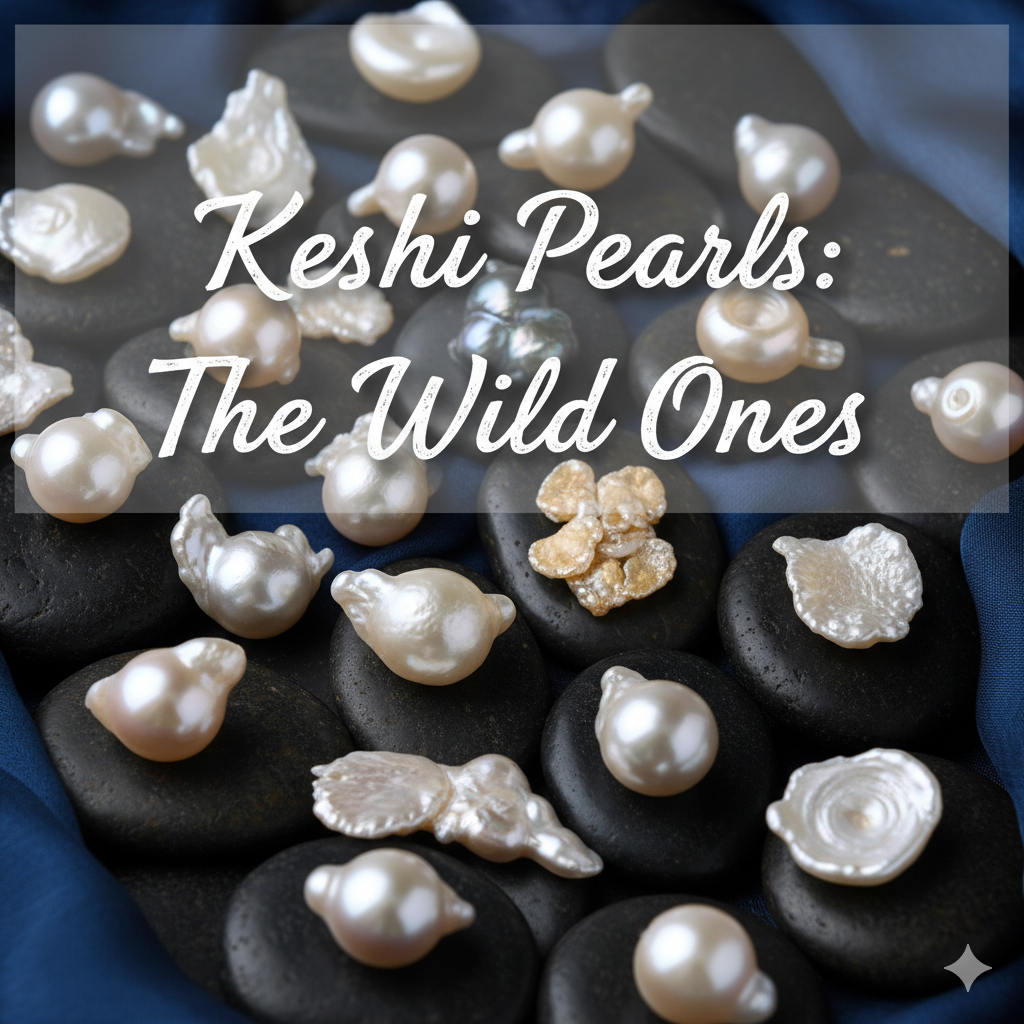Introduction
1) The Rebels of the Pearl World
Most pearls follow a plan.
A technician implants a nucleus; an oyster obliges with layers of nacre — symmetry, roundness, control.
But sometimes, the sea refuses choreography.
Sometimes, the oyster rejects the bead, and yet continues to coat the void with nacre — free, organic, uncontained.
What forms then is called a Keshi pearl — a gem born by accident, yet shaped by instinct.
In Japanese, keshi means poppy seed — a reference to its small size. But today, the word represents freedom itself: pearls without a nucleus, without pretense, entirely nacre.
They are the wild children of the ocean, unpredictable, luminous, and often far more alive than their perfect round cousins.
2) What Exactly Is a Keshi Pearl?
In the simplest sense, a Keshi pearl is a non-nucleated pearl formed as a by-product of pearl culturing.
During farming, an oyster may expel or fail to accept the implanted nucleus. However, if a piece of mantle tissue remains inside, nacre deposition continues. The result is a pure-nacre pearl — solid, dense, and radiantly textured.
No bead. No plan. Just light and biology dancing unsupervised.
Core characteristics:
- Composition: 100% nacre
- Shape: Baroque, petal, oval, rice, or completely abstract
- Luster: Exceptionally high (because no nucleus interrupts light diffusion)
- Colours: White, silver, champagne, pink, gray, blue, black, golden — depending on the host oyster
- Origins: Japan, French Polynesia, Australia, Indonesia, China
Keshi pearls can emerge from Akoya, Tahitian, or South Sea oysters, and even freshwater mussels.
Each carries its parent oyster’s DNA — a Tahitian Keshi gleams dark and metallic; a South Sea Keshi glows like candlelight.
3) Born of Rebellion, Raised by Light
There is poetry in their origin — the oyster’s quiet defiance.
While cultured pearls represent cooperation between man and nature, Keshis are the ocean’s unplanned answer — proof that nature still reserves the right to improvise.
They are smaller, often irregular, but their glow is legendary. Because they’re pure nacre, light doesn’t just reflect — it saturates, ripples, refracts.
Imagine silk folded underwater, catching sunrise.
That’s Keshi light — spontaneous, sensual, unpredictable.
4) Types of Keshi Pearls
Each region produces its own kind of wild beauty.
A) Akoya Keshi — Japan’s Minimalists
Tiny, delicate, often under 4 mm, Akoya Keshis have the purest mirror-white luster.
They are the zen whispers of the Keshi world — soft, disciplined, and elegant.
Used widely in minimalist Japanese jewelry, they embody restraint with radiance.
B) South Sea Keshi — The Golden Clouds
Born from Pinctada maxima, these pearls are typically larger (up to 10 mm), with champagne, ivory, and golden hues.
Their shapes resemble wind-blown petals — dramatic and organic, ideal for sculptural high jewelry.
They glow like soft light through antique glass.
C) Tahitian Keshi — The Dark Flames
The black-lip oyster (Pinctada margaritifera) produces Keshi pearls with hypnotic shades of peacock, graphite, and silver-green.
Their texture is often metallic — a fusion of rebellion and refinement.
Tahitian Keshis feel like the ocean’s reflection at midnight — alive, complex, magnetic.
D) Freshwater Keshi — The Artists’ Palette
China’s freshwater mussels produce abundant Keshi-like pearls in pink, lavender, peach, and white.
They’re fluid, painterly, and accessible — the artistic medium of designers who prefer imperfection over symmetry.
5) Shape, Texture & Luster
If round pearls are a melody, Keshis are jazz — improvised, irregular, and brilliant.
Their forms include:
- Petal: flat and radiant like flower petals
- Baroque: irregular, expressive, modern
- Rice: small and symmetrical with soft glow
- Button: subtle, wearable, softly domed
And yet, their greatest charm lies not in shape but surface.
Tiny undulations and folds act like micro mirrors, scattering light.
This gives Keshi pearls an almost liquid luster — described by jewelers as “hyper-nacre shine.”
Unlike bead-cultured pearls (whose brightness depends on uniformity), Keshis display multidirectional reflection — a phenomenon that gives them cinematic allure under natural light.
6) Colour: The Palette of Freedom
Keshi pearls inherit their hue from their parent oyster and lagoon environment:
- Akoya Keshis: White, rose, cream
- South Sea Keshis: Gold, champagne, silver
- Tahitian Keshis: Black, blue-green, peacock, gray
- Freshwater Keshis: Pink, lavender, orange, ivory
Natural colours are never forced. In fact, the uneven tone variations within a Keshi strand are what give it life — each pearl slightly different, each like a brushstroke in motion.
That asymmetry makes them irresistible to modern designers. The contrast between controlled gold and free-form Keshi is what makes fine jewelry feel human again.
7) The Fashion Renaissance
Once dismissed as by-products, Keshi pearls have become the darlings of high jewelry.
Their irregular silhouettes fit perfectly into a world that now celebrates authenticity and artistry over uniform perfection.
In Paris and Milan ateliers, Keshis are hand-set in molten gold, paired with rough diamonds, or suspended alone like droplets of light.
Brands such as Mikimoto, Yoko London, and Assael use them in couture-level creations.
But independent designers — from Kyoto to Jaipur — adore them even more for their individuality.
In fashion, Keshis are the couture pearl — unpredictable, unrepeatable, unforced.
They embody what the 21st century finds luxurious: personality.
8) The Emotional Signature — Imperfect Beauty
Keshis remind us that perfection is not the only path to beauty.
Their folds, asymmetries, and curves tell stories of survival. Each one began as an error — an oyster’s rebellion — and ended as light.
In that sense, a Keshi is more than ornament; it’s philosophy in nacre.
It stands for independence, creative risk, and resilience — the aesthetic of those who see elegance in authenticity.
No two are ever the same, which is why they make the most personal jewelry imaginable.
9) Value and Grading
While traditional pearls are graded by roundness and symmetry, Keshis are evaluated on:
- Luster intensity (the deeper the glow, the rarer the piece)
- Surface cleanliness (minor texture is natural and acceptable)
- Colour purity (natural, not dyed)
- Size (Tahitian and South Sea Keshis can exceed 10 mm)
- Shape appeal (fluidity, proportion, aesthetic balance)
Their market price depends heavily on origin and artistic use rather than uniform metrics.
High-end South Sea or Tahitian Keshis can rival cultured rounds in value due to nacre quality and rarity.
Unlike regular pearls, every Keshi is unique inventory — once sold, it cannot be replaced.
10) How They Differ From Cultured Pearls
| Feature | Keshi Pearls | Cultured Pearls |
|---|---|---|
| Nucleus | None | Bead nucleus present |
| Composition | 100% nacre | Partial nacre layers |
| Luster | Deep, multi-directional | Uniform, surface reflection |
| Shape | Free-form, baroque | Round or symmetrical |
| Origin | By-product or natural accident | Controlled process |
| Symbolism | Freedom, authenticity | Precision, refinement |
Both are beautiful — but Keshis whisper of individuality, while cultured pearls speak of discipline.
11) Keshi vs Baroque Pearls
They’re often confused, but there’s a distinction.
All Keshi pearls are baroque, but not all baroques are Keshi.
- Keshi: 100% nacre, no nucleus, spontaneous.
- Baroque: May contain nucleus, simply refers to irregular shape.
Think of baroques as styled imperfection and Keshis as born imperfection.
12) How to Wear Them
Keshis have become the choice of the modern minimalist and the quiet maximalist alike.
- Single statement earrings: One petal-shaped Keshi paired with gold or diamond studs.
- Layered strands: Multi-tone Keshi necklaces worn short or asymmetrical.
- Organic rings: Freeform Keshis bezel-set in textured metal.
- Bohemian stacks: Small freshwater Keshis mixed with beads or chains.
They pair equally well with linen or silk, denim or couture — because they belong to no rule.
13) Care and Longevity
Despite their artistry, Keshis require the same care as all pearls:
- Wipe gently after wear.
- Avoid sprays, lotions, and perfumes.
- Store flat on soft fabric, not hanging.
- Restring annually for necklaces.
- Let them breathe — pearls dislike airtight boxes.
Their nacre is pure and thick, so they often age more gracefully than regular cultured pearls — developing a mellow, golden undertone with time.
14) The Collector’s Eye
Collectors adore Keshi pearls for their one-of-one appeal.
No two pieces are ever identical.
High-value Keshis (especially from early South Sea harvests of the 1980s and 1990s) are becoming museum-grade examples of nature’s improvisation.
Some connoisseurs even refer to them as the “Rothkos of the pearl world” — abstract, emotional, undefinable.
15) Symbolism and Modern Appeal
Keshis have become the emblem of quiet rebellion in luxury.
They appeal to those who wear confidence softly — people who appreciate things that cannot be copied.
To wear a Keshi is to say:
“I value light in its wildest form.”
It is the gem of artists, thinkers, and explorers — of those who find meaning in irregular grace.
16) Summary Checklist
✅ Type: Non-nucleated, 100% nacre pearls
✅ Origins: Japan, Indonesia, Australia, Tahiti, China
✅ Colours: White, silver, gold, black, peacock, pink, lavender
✅ Shapes: Petal, baroque, button, oval, abstract
✅ Luster: Deep, multidirectional, mirror-satin hybrid
✅ Symbolism: Freedom, authenticity, individuality
✅ Care: Wipe softly, avoid chemicals, store gently
✅ Jewelry Style: Modern couture, natural luxury
17) Closing — The Wild Ones
Every Keshi pearl is a refusal to conform.
It is an accident that found its rhythm, a mistake that turned to melody.
It doesn’t follow light — it creates its own.
When you wear one, you don’t wear a pearl.
You wear a story of rebellion that the ocean wrote in nacre.
At PreciousCarats, we see Keshis as the proof that luxury and authenticity can coexist — that beauty does not have to be perfect to be powerful.
Some gems are planned.
Keshis are born free.

